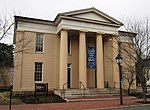Beulah Baptist Church

Beulah Baptist Church (Alexandria, Virginia) was established in 1863 in an African-American neighborhood ("the Bottoms") in Alexandria, Virginia, United States. The church was also the first black church founded in Alexandria after occupation by Union troops in 1861. Rev. Clem Robinson, graduate of Ashmun Institute in Pennsylvania (now Lincoln University), heard the call to educate and preach to slaves that lived in or fled to areas occupied by Union troops, so he came to Alexandria, VA. With support from the American Baptist Free Mission Society of New York and the (Northern) American Baptist Home Mission Society, he worked with his wife, with Miss Amanda Borden, and with Rev. George Washington Parker to found several schools for escaped slaves, including "The First Select Colored School," which served over 700 students in its first year. Their schools, which included a night school for adults and a Normal and Theological Institute for those with some education, preceded the federal schools, set up by the Freedman's Bureau, by many months. The Beulah Baptist Church was founded the next year, 1863, and remains a vital African American congregation to this day. Currently, it is under the able leadership of Rev. Prof. Quardricos B. Driskell In the founding days, Rev. Clem Robinson also taught upper level students at the "Beulah Normal and Theological Institute," which met at the church and which had over 80 students in the first few years. The aim was to educate future teachers and preachers for the Black community, men and women, and this school placed over 30 missionaries and educators into the field in the first few years. This pioneering effort preceded any other Black Normal and Theological Institute in the Reconstruction period, including Wayland Seminary (later Virginia Union, 1865), Fisk University (1866) Howard University (1867), and the Hampton Institute (1868)Robinson and Parker assisted the efforts of other pioneers for Black education in Alexandria, like Harriet Jacobs and Julia Wilbur. Robinson's school remained in place until 1870, when Alexandria opened its public school system. The church was also the first black church founded in Alexandria after its Union occupation in 1861.It is a two-story brick building with a gable roof and large stained glass window. The church is located at 320 South Washington Street in Alexandria, Virginia.
Excerpt from the Wikipedia article Beulah Baptist Church (License: CC BY-SA 3.0, Authors, Images).Beulah Baptist Church
Prince Street, Alexandria
Geographical coordinates (GPS) Address Nearby Places Show on map
Geographical coordinates (GPS)
| Latitude | Longitude |
|---|---|
| N 38.803888888889 ° | E -77.0475 ° |
Address
Prince Street 700
22314 Alexandria
Virginia, United States
Open on Google Maps








